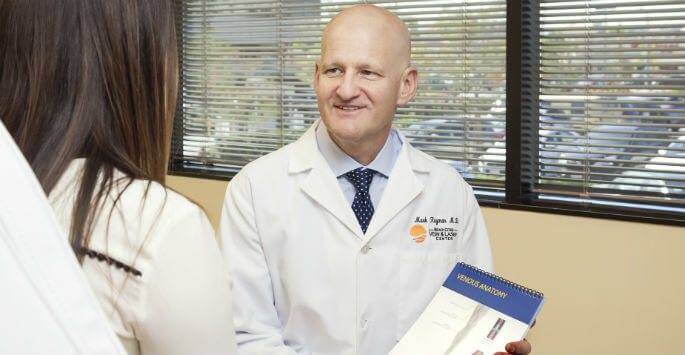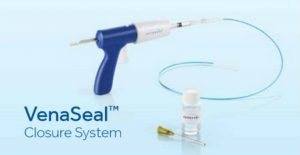We’re pleased to share that Dr. Rayman’s interview with Radio Health Journal has aired and posted online as a result of our proactive outreach. Dr. Rayman did a GREAT job delivering key messages about venous disease, drawbacks to the treatment landscape (vein stripping, heat-based treatments) and the benefits of VenaSeal™: faster procedure, less painful, no chance of recurrent varicose veins and little-to-no bruising or risk of nerve damage that’s associated with heat-based treatments. Dr. Rayman also shared that, “the best advantage about VenaSeal™ is immediately after the procedure a Band-Aid goes on, the patient gets up, walks out of the room and can resume normal activities. Most people do not have to wear compression stockings afterwards, which is sort of something that is mandated with patients who have laser or radio frequency ablation; they have to wear compression stockings for somewhere around two weeks in most practices.”
Radio Health Journal is syndicated on 500 radio stations across the country and, per Cision, the show averages 2.1 million listeners per quarter hour. For more, you can listen to the segment here. The online article is also below, which drives readers to MDT website/physician finder for more. Radio Health Journal also published the story on Twitter (followers: 400) and on Facebook (likes: 607).
Synopsis: Millions of people have varicose veins, which have health consequences beyond their unsightliness. An expert physician explains what varicose veins are and new treatments that simplify getting rid of them.
Guest:
- Dr. Mark Rayman, Medical Director, Beach Cities Vein and Laser Center, CA
Link for more information:
- VenaSeal Closure System
Varicose Veins
Nancy Benson: Summer brings tank tops and shorts. But if your legs don’t look the way you’d like, you may be too self-conscious to wear your summer clothes. Dr. Mark Rayman, medical director of Beach Cities Vein and Laser Center in California says varicose veins are one of the biggest reasons to keep legs hidden. And they’re more common than you may have realized.
Mark Rayman: If you look at the statistics, about 23 percent of all adults have visible varicose veins on their legs. And when I say adults, its anywhere from age 18 on. If you look at people who are 50 and over, literally 50 percent of them will have them at some point.
Benson: Rayman says as you age, your chances of having varicose veins increase. So exactly what is a varicose vein?
Rayman: A varicose vein is a dilated, twisting, bulgy vein that most commonly is visible to the naked eye. It actually protrudes from the skin. It looks like a finger-like or worm-like projection. As opposed to the little tiny spider veins which are the little ones that are seen at the skin surface that are quite tiny, the varicose veins are much larger and are typically more indicative of an underlying medical problem.
Benson: That means doing something about it is important for more than just your looks. And not seeking medical treatment can cause severe medical issues.
Rayman: There’s a constellation of symptoms that people describe with varicose veins. And they include things like aching, cramping, throbbing pain in the legs with pull on standing but sometimes that pain can occur in bed at night. Sometimes patients have itchy skin, leg swelling, leg heaviness or fatigue or restless legs. And if they wait for a prolonged period of time and don’t do anything about it, eventually there will become changes in the skin in the lower part of the legs where the skin will start to turn darker. In some patients, that can lead to open wounds called ulcers.
Benson: Rayman says the structure of your veins is important in the formation of varicose veins.
Rayman: There are two types of veins in the legs, superficial veins, which run closer to the skin’s surface and deeper veins, which obviously run deeper. And they run parallel to each other like the rungs of a ladder. The superficial veins need to drain into the deep veins and there’s different ways they do it. They can do it through side-to-side branches, kind of like the steps of a ladder, so that the blood drains from the skin’s surface toward the deep system. And then the superficial veins can also join the deep veins at the top of the thigh or behind the knee. So, you have to understand, when people get varicose veins, it’s usually a problem in the superficial venous system that is causing their varices.
Benson: Rayman says your veins have valves, which prevent blood from flowing backwards. At least that’s how they’re supposed to work. When they don’t, they produce varicose veins.
Rayman: What happens usually is the valves go bad in the superficial veins and where those superficial veins connect to the deep veins because the pressure is deeper in the deep vein, the blood exits from the deep vein and goes downhill in the superficial vein. So instead of the blood draining normally towards the heart in the superficial vein, it reverses flow and starts to travel down the leg. And when that happens, then the little tributaries that normally drain up into it, they become engorged and they form varicose veins.
Benson: Rayman says there are a number of factors that could make you at risk of developing varicose veins.
Rayman: Heredity is by far the number one factor. If one of your parents has varicose veins, you have a 50 percent chance of getting it. And if two of them or two of your siblings have it, then you have a 90 percent chance. It’s definitely genetics, number one. But there are a lot of patients who have no genetic history who get varicose veins and who are those patients? They’re people who have jobs that require prolonged standing in one place or prolonged sitting in one place where they’re not engaging their calf muscles. Because their calf muscles need to help to pump the blood back to the heart, and if they’re just sitting at a desk not using their calf muscles, they’re standing in one place where gravity is having an affect… that will lead to an increase risk of having varicose veins. And then there are other factors associated with varicose veins, which include multiple pregnancies, advancing age or trauma.
Benson: Rayman says people with varicose veins are often fearful of having them treated because of the horror stories they’ve heard. But those usually involve antiquated treatment techniques.
Rayman: Stripping is a procedure that was typically done in the operating room where an incision was made at either the ankle or the knee and another several centimeter or two or three inch incision was made at the groin, and a metal rod was threaded through the vein from the knee or ankle up to the groin. And then at the groin, all the little vein branches that tied into the great saphenous vein which is where it usually occurred… they would disconnect it, they would pull the whole vein out, they would literally strip it out from the knee or from the ankle. And it caused a lot of bruising, a lot of pain. But most importantly I would say was a high recurrence rate, there was about a 15 to 30 percent recurrence rate.
Benson: New technologies have fortunately replaced stripping. The two most common ones rely on lasers or high-energy waves to generate heat for vein treatment. Rayman says the drawback of these therapies is that they require multiple needle sticks, and may result in bruising, swelling, and a long recovery period. The treatments do the job, but Rayman prefers a new technique, which is faster and a lot less painful. This technique is called VenaSeal.
Rayman: VenaSeal is a procedure where one puts numbing in just one tiny little spot, makes one tiny knick and advanced a catheter up the vein and deposits tiny drops of adhesive in the vein and then you press on the vein for three minutes at the top of the thigh and then thirty seconds at three centimeter intervals down the thigh as you seal the vein shut. So the procedure is very fast, it’s very elegant and has several advantages over laser and radio frequency ablation.
Benson: Rayman says with this procedure, there’s no chance of recurrent varicose veins. There are a number of other benefits as well.
Rayman: Because you’re only numbing in one spot, they get very little to no bruising and because you’re not using heat energy which one would use with laser ablation or radio frequency ablation, since you’re not using heat there’s no risk of any heat damage to any surrounding tissues such as adjacent nerves which does happen once in a grey while with those other techniques. But probably the best advantage I would say, if you ask me what’s the greatest thing about VenaSeal, is immediately after the procedure, a band aid goes on, the patient gets up, walks out of the room, can resume normal activities and most people do not have to wear compression stockings afterwards, which that is sort of something that is mandated with patients who have laser or radio frequency ablation, they have to wear compression stockings for somewhere around two weeks in most practices.
Benson: That means the days of painful and invasive treatments for varicose veins are gone- just in time for shorts season. You can find out more through links on our website, radiohealthjournal.net.




